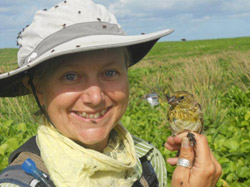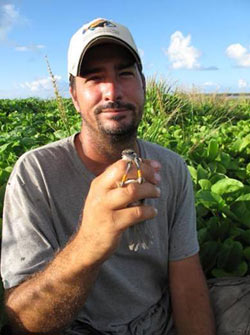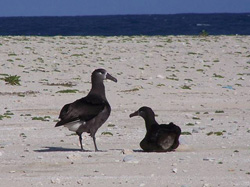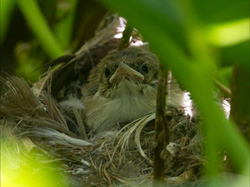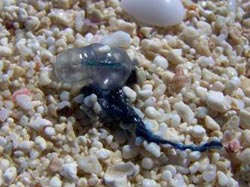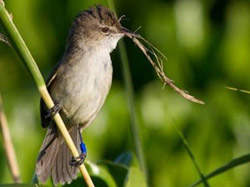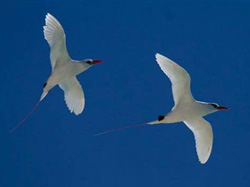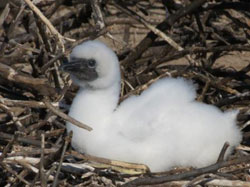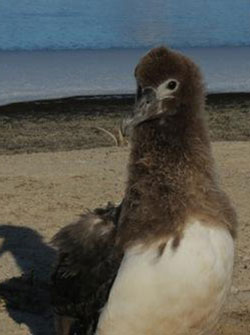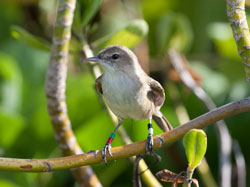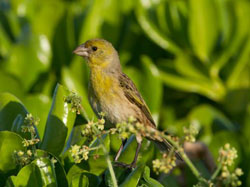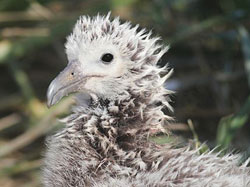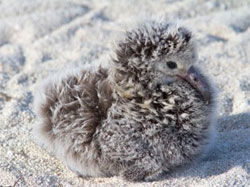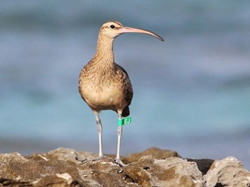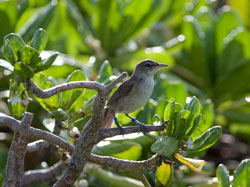2012 Update on the Nihoa Millerbirds on Laysan Island
– New Hope for Critically Endangered Species
The Millerbird Translocation Project is a partnership of the U.S. Fish and Wildlife Service and American Bird Conservancy within the Papahānaumokuākea Marine National Monument and World Heritage Site. The Monument is managed by the Departments of Interior and Commerce and the State of Hawai'i as Co-Trustees.
Evacuation
October 29, 2012 - November 20, 2012
By Michelle Wilcox
On November 4th all personnel were evacuated from Laysan Island, and the camp was closed for the duration of the winter season. The problem began with a medical issue (everyone is okay), but was exacerbated by the fact that the winter season prevents boats from landing in the area. Thus, evacuation was used as a preventative measure to ensure human safety. The camp will reopen in March of 2013, at which time I, along with another biologist, will return with the Fish and Wildlife Service's habitat restoration crew to monitor Millerbirds through the summer.
The current wave of breeding was nearing its end with only two sets of nestlings left when I departed. Another fledgling was added to the population for a total of 29 Millerbird juveniles produced by translocated birds in 2012. The number of adults molting their feathers was increasing, and we suspect they will now begin their winter quiet period. In the winter months last year, Millerbirds were difficult to detect because the birds spent this time quietly foraging in the depths of the naupaka shrubs, and the males were not singing their territorial display songs as often. On the bright side, I would say that if there were a BEST time of the year to halt our observations, it would be during the winter.
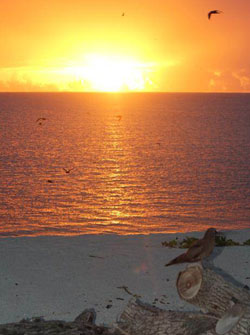
(Figure 2) The sun sets on this tour of Laysan Island, only to rise again in early 2013. Credit: Michelle Wilcox.
When we return in March, we expect to find the birds in the middle of their first wave of nesting for the year 2013. It will be interesting to see which pairs remain together and which adults move around to new partners or new territories, which young birds begin breeding before they are a year old, and which birds, if any, cannot be found and may not have survived the winter. The birds should do fine despite the absence of their human peeping-tom neighbors.
My 'Nature Sight of the Week' goes to the ubiquitous and gregarious Laysan Finch (Telespiza cantans) (Fig 1.). This endangered species is endemic to Laysan Island; they persisted despite the decimation of the vegetation on the island by rabbits in the early 20th Century. We speculate that one of the reasons this species survived when others – such as the Laysan Millerbird, 'Apapane, and Laysan Rail did not – is that they are curious generalists. Gangs of them are found in almost every habitat type on the island busily pecking at everything to see if it can be eaten. While you are standing in place looking through binoculars they will hop onto your boots and start pecking at the grommets and laces. When you stick your head into a naupaka bush in search of Millerbirds, a few finches will hop over, inches from your face, to take a look at you. We caught this finch because he decided to investigate whether the nets we had set up to capture unbanded Millerbirds were edible. In camp they land on the screen door of the kitchen and work on tearing the screen with their bills so they can get inside and explore for edibles. They have also pecked holes in our propane gas hoses and made their way into personal tents where they leave 'tokens' of their respect. Although sometimes annoying, they provide entertainment for behaviorists like myself. I cannot wait to return to Laysan Island and learn more about their social system; indeed, there is so much more on Laysan to explore!
Changing seasons
October 15, 2012 - October 28, 2012
By Michelle Wilcox
The Millerbirds and I bid bon voyage to Robby Kohley on October 16th. While he was here, he talked a lot about wanting to come full circle with Millerbirds by capturing an unbanded juvenile that was born of parents he helped move from Nihoa Island to Laysan last year. Robby has been a key part of this project since 2009. He performed pre-translocation feeding trials on Nihoa to make sure that we could keep Millerbirds in captivity for the length of time needed to move them between islands, and then lived on Laysan for six months after the first translocation last year to monitor the birds' survival and productivity . Sure enough, just before he left, we were able to capture a young, unbanded Millerbird that was born on Laysan earlier this year, and Robby was able to band it with his "signature" color (Fig. 1).
Meanwhile, the Millerbirds have been busily engaged in making more Millerbirds. For this wave of breeding, we now have five fledglings and three nests with nestlings still being fed. A number of the birds that just came from Nihoa are going through a molting period, which means there are Millerbirds hopping around without tails. They look a little bit like they forgot to put their pants on. I have noticed that the resident birds that have been here since 2011 have been more successful at breeding in this wave than the newly moved birds. We have had a number of failures so far, but all by new birds.
The charter vessel Kahana that took away Robby and the summer crew dropped off the winter crew, who will be staying with me on Laysan through April. We experienced our first tsunami warning on the night of October 27 from the earthquake near the Queen Charlotte Islands, off the central coast of British Columbia. We did not see much wave action, but we did have a smooth test of our emergency procedures.
My 'Nature Sight of the Week' is the arrival of Black-footed Albatrosses to Laysan to begin their breeding season (Fig. 2). These birds have been summering in the far north Pacific Ocean from Japan up to the Bering Sea and over to the North American coast, where they have been feeding on flying-fish, squid, and crustaceans. The first two were sighted on Sunday October 21 and more are arriving each day. The island will host up to 25,000 pairs, second only to Midway, which harbors the largest breeding colony of this species in the world. They will do an elaborate courtship dance that includes a simultaneous series of postures and calls by the male and female featuring moves such as a bow with wings extended, a 'Sky Call' performed on tip-toe, and 'Head Up Clacker,' in which the bill is rapidly clapped together.
Along with the 28 Black-footed Albatrosses, there is one Laysan Albatross on the lake edge and one Short-tailed Albatross in the North Desert. There are at least six Northern Pintails on the lake. Three juvenile Red Phalarope were seen swimming and foraging in the lake, and a Dunlin was also sighted. We continue to see Sharp-tailed Sandpipers (40+), a few Pectoral Sandpipers, and two Bar-tailed Godwits. The expected Ruddy Turnstones, Wandering Tattlers, and Pacific Golden Plovers are all along the lake edges.
Editor's note: see the blog posts below from Robby and Cameron Rutt describing their September 2011 - March 2012 monitoring work on Laysan.
Changing seasons
October 1, 2012 - October 14, 2012
By Michelle Wilcox and Robby Kohley
This two-week period has been full of excitement. Two of our Millerbird nests have fledged chicks. One of the nests was built by a male and female translocated from Nihoa and released on Laysan on August 18th of this year. They began building a nest 17 days later, laid eggs, incubated for about14 days, fed nestlings for another14 days, and fledged the chicks this week (Fig. 1)! This is an amazing example of the success of the translocation of this species: in just over two months the two parents have "replaced" themselves with two juveniles added to the population. Two additional nests have nestlings, and at least five pairs are still incubating eggs.
The high number of Sharp-tailed Sandpipers continues (40+); this week had a high of six Pectoral Sandpipers; we gained another Ruff for a total of three on the island; and at least one Bar-tailed Godwit is still around. At least two Long-billed Dowitchers were seen this reporting period during the shorebird survey performed by the U.S. Fish and Wildlife Service volunteer staff.
My 'Nature Sight of the Week' came after four days of storms offshore that brought continuous violent crashing waves to our beaches; waves as tall as me and the color of blue crystal and sea green. They were beautiful yet dangerous. The waves threw a lot of broken coral, sponges, crabs, and other sea creatures onto the beach in lines of sea wrack. While poking through it and looking for seashells and glass balls (Japanese fishing floats treasured by beachcombers throughout the Pacific Islands), I found a tiny electric blue bubble about the size of a fingertip with a blue tail trailing from it (Fig. 2). Intuitively I did not touch it, but picked it up with a large morning-glory leaf and brought it to my island-mate who helped me identify it as a Pacific Portuguese Man-Of-War (Physalia utriculus). Called paʻimalau in Hawaiian and related to the jellyfish, it is actually a colony of specialized hydroids that act as one creature. They use stinging nematocysts on their tentacles to immobilize prey and then draw it into their digestive tube. The bubble, only one to two inches long, is a float used to ride on the sea surface, and when there are strong winds it forms a crest that can act as a sail. I found a total of eight of these creatures, but sometimes hundreds can be found after a storm. They do sting, but they are not as deadly as the Atlantic Portuguese Man-of-War (Physalia physalis) which can have a float up to a foot in diameter and tentacles up to 30 feet long.
The high wave action prevented the new crew of biologists arriving on the M/V Kahana from landing their zodiac on Laysan and disembarking. Instead, the ship sailed on northward to Midway and we will perform the crew change this coming week, on Kahana's way back south. This eliminates the week of overlap and information exchange with the summer crew that we were hoping for, but Laysan and I will still get five new people to spend the winter with. Sadly, though, I will be losing the help of Robby Kohley.*
Editor's note: Robby Kohley has been a core member of the Millerbird Team since 2009. As long-time readers know, he and Cameron Rutt participated in the first translocation and were the first biologists stationed on Laysan to monitor Millerbirds, through the winter of 2011-12. Scroll down to see Robby and Cameron's blog posts.
Nests, nests everywhere
September 17, 2012 - September 30, 2012
By Michelle Wilcox and Robby Kohley
There are currently sixteen pairs of Millerbirds with nests on Laysan Island. That is a new record since the species was reintroduced to Laysan last year. Of the 24 birds that were moved to Laysan in 2011, we have six pairs that have turned right around after their most recent breeding attempt and started new nests. This will be the fourth round of nesting attempts in 2012 for some of these Laysan veterans. The newly translocated birds (released just over a month ago) have formed ten pairs – that we know about so far. The most advanced nests could be hatching young any day. Fall was an unproductive nesting season last year for Millerbirds so we are reserving our excitement and not counting our chicks before they hatch!
Some of the juvenile males that fledged on Laysan earlier in the year are starting to sing and defend territories in their first attempts to mate. We have not yet detected any females in their territories, but females can be much more difficult to detect as they quietly forage below the dense canopy of the shrub layer. We call ourselves lucky when we find a female that actually makes call notes once in a while.
My (Michelle's) 'Nature Sight of the Week' is a courting group of Red-tailed Tropicbirds. While checking Millerbird nests last week at Tern Rise (one of the subtle landmarks we use to locate nests and territories), I heard many birds calling from above me. I looked up to see five tropicbirds squawking and flying in a group like a Ferris wheel going backwards. The front bird would fly higher and then backwards and drop in behind the others. Then the tropicbird would point his two red, elongated central tail feathers first to the right, then to the left. I have since learned that these flights take place above prospective nest sites, and eventually, one of the birds will land near the site as though trying to interest a mate in the location he has chosen.
September 3, 2012 - September 16, 2012
By Michelle Wilcox and Robby Kohley
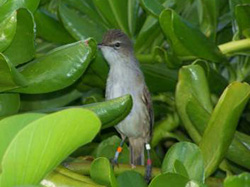
(Figure 1) One of the second group of Millerbirds translocated to Laysan peeks from the naupaka. Credit: Michelle Wilcox.
The newest group of 26 Millerbirds on Laysan Island (all present and accounted for) is defending territories, pairing up and building nests. Nine pairs are exhibiting some stage of early nesting behavior. Last year's translocated birds also attempted breeding about a month after they arrived, but their attempts were unsuccessful. We are hoping that the combination of a wet, green, insect-filled landscape, the timing of molt and the presence of other breeding Millerbirds on the island will combine to make this year's fall attempts more successful.
Of the six nests that were active at the end of John Vetter's term, three have fledged six new young Millerbirds. That brings the total count of free-flying Millerbirds hatched on Laysan to 23! That's almost as many birds as we brought to the island in 2011 after an absence of about 90 years! Now that we have added more Nihoa birds to the mix those numbers should keep on growing.
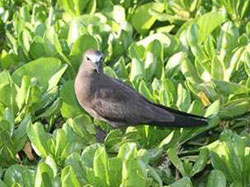
(Figure 2) The brown noddy (Anous stolidus) is one of the many seabird species nesting on Laysan. Credit: Michelle Wilcox.
A number of Pacific Ocean storms passed over us this week, which brought an influx of shorebirds to the island. Robby has spotted over 40 Sharp-tailed Sandpipers, 2 Bar-tailed Godwits, 2 Ruff, 2 Pectoral Sandpipers, a Semipalmated Plover, 3 Lesser Yellowlegs species, and five Cattle Egrets (bad news, since Cattle Egrets eat the chicks of nesting seabirds). This is in addition to the high numbers of Pacific Golden-Plovers, Wandering Tattlers, and Ruddy Turnstones that have been here since their breeding seasons ended in Alaska.
My (Michelle's) 'Nature Sighting of the Week' is my voyeuristic encounter of two Brown Noddies, which stood facing each other with their heads on each others shoulders neck-to-neck (if only their wings could have wrapped around each other, they could have been hugging) and PURRING to each other! Now, the Brown Noddies make a slew of raucous calls, screeches, and ear-piercing whines, but I had never heard them make this low-toned cooing sound. Witnessing it made me stop along my path as though I had hit a wall, it was so sweet and private that I felt like I should shut a door and leave them alone.
August 20, 2012 - September 2, 2012
By Michelle Wilcox
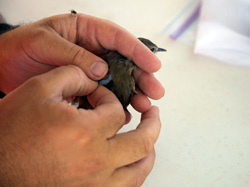
(Figure 1) A Millerbird receives a radio transmitter. Credit: Ryan Hagerty/US Fish and Wildlife Service.
Last week Laysan Island bid farewell to John Vetter, Millerbird Monitor for spring and summer 2012. He left a trove of information from his detailed observations of Millerbird behavior and reproduction that we will continue to build upon. The island welcomed not only 26 more translocated Nihoa Millerbirds, but me, Michelle Wilcox, the newest Millerbird Monitor for fall and winter, along with Robby Kohley who is here to help with translocation, post-translocation monitoring, and to train me on all things Millerbird-related. Robby first came to Laysan in September 2011 with Phase 1 of the Millerbird translocation project and monitored Millerbirds along with Cameron Rutt for the first six months after Millerbirds were released. I am very grateful for being able to tap into his wealth of knowledge and his history with this species.
We attached temporary radio transmitters to each of the newly released birds that will emit signals for 21-35 days and allow us to track the birds' locations. Twenty-five of the birds have been re-sighted and are doing well and displaying interesting dispersal patterns. Some are moving to the edges of the current 'core area' of Millerbird activity in the northern part of the island, while others are carving out parcels in between the territories of males that have been here for a year. Some of the new birds are even exhibiting signs of early courtship behavior. The twenty-sixth bird is a quiet female. We believe her transmitter is not working which means she will be much harder to find, but we hold high hopes of finding her during interactions she may have with other Millerbirds.
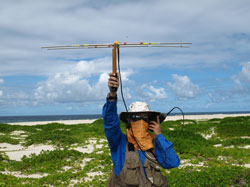
(Figure 2) Michelle Wilcox tracking Millerbirds. While Millerbirds eat flies, they clearly don't eat enough! Credit: Chris Farmer/American Bird Conservancy
We have also been monitoring the six Millerbird nests that John had found in his last month on the island. Two of the nests have produced a total of three fledglings, and four nests are in the nestling stage. This brings the grand total of chicks fledged thus far in 2012 to 20! This is fantastic news for the species and a huge success for the translocation project in general. There is still plenty of unoccupied habitat and there are plenty of insect food resources for all of these new birds to thrive and expand their population.
The island is an orchestra of bird song all through the night with Wedge-tailed Shearwaters and Christmas Shearwaters doing their mating calls and Brown Noddy chicks begging for food. These three species are still producing chicks all over the island, whereas Bonin Petrels are just starting to arrive in small numbers. We see juvenile White Terns and Great Frigatebirds scattered around the island as well as a few Masked Boobies and Red-footed Boobies still waiting to be fed by adults. For all of these species Laysan Island is a rare breeding refuge free from mammalian predators, and for this reason tens of thousands of seabirds come here to nest.
Instead of Resight of the Week, I want to start a new series called Nature Sighting of the Week. This is going to be hard since I am new here and everything is wondrous and fascinating to me, but if I had to pick one from the past week, I would choose the Christmas Wrasse that came to visit me in the shallows of the camp beach on my first day on Laysan. This 8 inch fish is dressed in the most vivid blues, greens, and yellows that he looks like his colors have been enhanced for cinematic effect. It is as if he was saying, "Welcome to Laysan. If you are observant and patient enough we will put on quite a show for you!"
August 6, 2012 - August 19, 2012
By John Vetter
An action-packed two weeks was a great way to finish up my time on Laysan. The arrival of the translocation crew from Nihoa with 26 more Millerbirds went very smoothly and was a great success overall. This also marks the return of Robby Kohley to Laysan and the arrival of Michelle Wilcox, who will take over monitoring and tracking responsibilities. But, before I left, I was able to document the continued success of the current population of Millerbirds on Laysan, as three new nests (and a probable fourth) were found during the past two weeks, bringing the total to probably six active nests Let's hope that the new arrivals take to the island as well as the previous cohort.
The other island inhabitants continue to do well, as large numbers of Sooty and Gray-backed Tern fledglings are moving around the island. Also, the first fledgling Brown Noddies have been noted. Large numbers of cute bundles of puff in the form of baby Wedge-tailed Shearwaters are showing up in many areas of the island. This period also marked the first indications of fall migration, as up to seven Sanderlings were found foraging around the interior lake. A number of the Pacific Golden-plovers and Ruddy Turnstones also appear to be fresh arrivals from the northern breeding grounds.
This last blog post from me also has me looking back on my time on the island, and some of the key life lessons that I have learned. Such as:
- A rainbow moving away from you is beautiful; one moving toward you means you are going to get wet.
- If a double rainbow is coming at you, you are going to get twice as wet.*
- A clean pillow is a luxury often overlooked.
- When the flies are really bad, always face the wind when drinking from your Nalgene.
- Some smells linger for a long, long time.
- Finally, as I have learned from the Brown Noddies, sometimes you just need to stop and stare at your feet to make sure that they are still on the ground.
*Not intended to be taken as scientific fact.
Beginnings and Endings
July 23, 2012 - August 5, 2012
By John Vetter
As my time on Laysan winds down to its last couple of weeks, a new cycle of breeding is beginning for the Millerbirds—their third since they were brought to Laysan from Nihoa just eleven months ago. Two active nests are in incubation, and a few more pairs might be looking to breed again as well. For me, this is somewhat bittersweet, as I will not be around to see many of these nests fledge, but, it is a great feeling knowing that the birds have already had a very successful season and seem intent on reclaiming the island as their home as quickly as possible. I hope that by the next time I write, they will be joined by another eager group of birds from the second translocation effort from Nihoa, which will be getting underway very soon.
Our 'Resight of the Week' feature seems to be increasingly awarded to female Millerbirds, and this week is no different, with female Bk/S, B/O (Black over Silver bands on left leg; Blue over Orange on right leg) deciding to show up right in the middle of her territory on a few different occasions. Where she has been for the previous 50 days, only she knows. I also have to mention the previous recipient, O/W, O/S, since she was once again observed (rare times indeed), and this time she was making her way to her nest to relieve the male of incubation duties.
Most of the Albatrosses have left, and the island has begun to feel a little empty. As some of the most numerous, largest, and most charismatic birds on the island, they tend to dominate the attention while they are here. Luckily, we still have the Brown Noddies. Also one of the more numerous species on the island, they show little fear of anything, even attacking the much larger and fearsome Great Frigatebirds. Now, we have little Brown Noddy chicks roaming around camp, investigating every little nook and cranny. With quite a bit of charisma themselves, these little guys are a pleasure to watch grow, as they perfect the "Noddy foot stare:" gazing straight down at their feet as if to make sure they're both still there. Another highlight of the period has been finding the first Wedge-tailed Shearwater chicks of the season, though, undoubtedly many, many more are to come.
On the shorebird front, we still have the main four species: Pacific Golden Plover, Ruddy Turnstone, Wandering Tattler, and Bristle-thighed Curlew, with individuals over-summering; no new migrants have arrived as of yet. We might still be a month or so away from the influx of rare and noteworthy shorebird sightings.
At It Again
July 9, 2012 - July 22, 2012
By John Vetter
Just when I think I have a good handle on the behavior and ecology of the Millerbirds, they throw me for a nice loop. The most exciting part of the last two weeks is that the birds have decided to start nesting again. Apparently they just needed a quick intermission to molt in some new feathers before raising some more chicks. I found one new nest this week, as well as seeing another pair with nesting material, and many of the pairs have become much more vocal again in the past week. Similar to most species, Millerbird breeding is resource-dependent. Millerbird numbers on Nihoa are thought to be close to the island's carrying capacity, but here on Laysan, with so few birds on a much larger island, plenty of room and food are available for them to spread out and raise young ones. Both pairs re-nesting so far have only raised one successful nest this spring and summer, but for some pairs, it could be lucky number three if they decide to try again.
The "Resight of the Week" is a pretty easy one this time around. The female O/W, O/S is by far the most difficult of the paired birds to find. This is only the 13th time she has been sighted in the ten months she has been on the island. It had been 80 days since I was last able to get a good look at her bands, and the resight was even better since she was in the process of grabbing some nesting material off the ground.
Around the island, much is going on at the moment. Albatross young continue to fledge, and the island has begun to empty of them. Quite a few other species have young that are starting to fly and become independent as well, including Red-tailed Tropicbirds, Masked and Brown Boobies, and Sooty and Gray-backed Terns. The first tiny chicks of the Bulwer's Petrel have been seen, as well as many Brown Noddy chicks. The Christmas Shearwater (another tubenose) also has chicks, with some beginning to come out of the grass-covered burrows where they were born: dark gray fluff-balls with heads too small for their body (or bodies too big for their heads?). Some of the larger chicks already have the distinctive Mickey Mouse-like calls down pat.
Other than that, the only noteworthy sighting was of a group of three Blue-gray Noddies at the south rock ledge. Rocky cliffs (the preferred habitat of the Blue-gray Noddies) are scarce on Laysan, with only this area in the south being of any substance. No indication of breeding has been seen, but we are keeping an eye on them.
Fledgling Independence Day
June 25, 2012 - July 8, 2012
By John Vetter
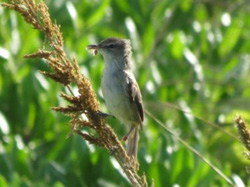
(Figure 1) A male Millerbird with a freshly-caught spider. The spider was fed to a fledgling after this photo was taken. Credit: J. Vetter
This two-week period was a study in contrasts for the Millerbirds, and showed how frustrating and rewarding working with this species really can be. The first week was hot and dry and many birds had begun post-breeding molt. Thus, birds were very quiet (two songs all week!) and I managed to find only four of them the entire week, often leaving me wondering if there really were Millerbirds on this island. However, cool, wet conditions prevailed the following week and suddenly they appeared everywhere, once again singing and moving about extensively in the foliage. While adults continued feeding their chicks early in the period (Figure 1), by the end of the two weeks many of the young fledglings had begun to strike out on their own. So keeping track of these little ones will become more difficult. Luckily for me, curiosity is a defining characteristic of hatch-year Millerbirds, and I do not have to find them as much as realize that they have already found me and are peering intently at me from a few feet away.
The Resight of the Week this week goes to Bk/Y, G/S. This small female is one of the more difficult Millerbirds to find due to her territory in very thick, dense vegetation. After last resighting her on May 19th, I found her again on July 6th quietly preening in the vegetation. Both her tail and her wings were fresh and still re-growing after molt.
The albatross colonies are beginning to thin, as many of the chicks took full advantage of the recent windy conditions to hone their flight skills and head out to sea. Many are still in the learning curve, however, and crash landings are common. One definitely needs to keep one's eyes and ears alert when walking around the interior lake, where many of the Laysan Albatross chicks are learning. More than once I have had to duck out of the way of an out-of-control fledgling. Among the other birds, the Brown Noddies have begun hatching. Seemingly every nest on the island hatched during a two-day period last week. More small Laysan Duck chicks have begun appearing as well, while many of the early chicks are now out on their own. As with young Millerbirds, these fledgling ducks are often found in groups and are extremely curious about the people working on the island.
There are still no unusual migrants or vagrants around the island, but the Bristle-thighed Curlews and Ruddy Turnstones are keeping many of the seabirds on their toes. Both of these species are known egg predators, especially the curlew. Anytime one of these birds flies around the island, it is accompanied by a strong contingent of vigilant seabirds, usually Sooty Terns. The Blue-gray Noddy continues its residence on the island, being found regularly in the heliotrope trees along the beach.
Quiet Mice and Running Rocks
June 11, 2012 - June 24, 2012
By John Vetter
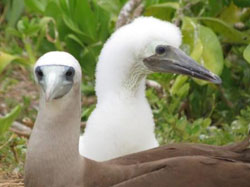
(Figure 1) A male Brewster's Booby and his chick. This subspecies of Brown Booby, distinguished by the male's pale head and bill, is uncommon in the Hawaiian Islands. Credit: J. Vetter
Summer is in full force out here on Laysan, which unfortunately means a slowing of the Millerbird breeding season. Singing has dropped dramatically the last two weeks, and our last active nest fledged two more chicks, bringing the season's total to 17 chicks fledged from 11 nests. Since most of the pairs are currently feeding fledglings, it may be another two to three weeks before we can officially put this season in the books, but at least a few pairs seem content with the young they have produced and have hung it up. A few of these have shown signs of post-breeding molt, with the birds losing their entire tails at once. This just reinforces the notion and appearance of quiet mice running through the vegetation.
One of the more important questions for us now is the dispersal and survival of the fledglings and juveniles. To that end, and for a clearer picture of the overall Millerbird population as we move forward, we have started banding these young birds as they leave their natal territories for parts unknown on the island. The Resight of the Week for this period goes to B/S, O/R, a female seen late last week after having eluded detection for over a month, despite feeding a young fledgling for most of this time.
Newly fledged Black-footed and Laysan Albatrosses have moved beyond the short air-time achieved from hopping into a strong wind to actually taking off from a running start, both from land and from the lake in the middle of the island, and flying around the island. With no down present and good control over their flight capabilities, many young Black-footed Albatrosses require a double-take to differentiate them from adults. In addition to these young birds fledging, many other young chicks have been hatching during the last two weeks. In particular, three species of tern now have chicks. Sooty Terns nest in vast colonies of hundreds of thousands of birds that ring the interior bunchgrass areas of the island, while Gray-backed Terns nest in smaller colonies of up to100 birds scattered throughout the low vegetation of the island. Both species have semi-precocial chicks that do their best to emulate a rock before darting out and running to another spot, where they then do their best to look like a different rock. The third species with new chicks are the bush- and tree-nesting Black Noddies, which build more traditional nests. These chicks (which would give any other chick on the island a run for the cutest) stay put in the well-constructed platform of leaves and branches.
No unusual migrants or vagrants showed up this period, which is to be expected in the summertime. We do, however, still have a couple of the brewsteri subspecies of Brown Booby nesting in the south of the island. One male has now been joined by a chick (Photo 1), while the other continues to incubate eggs.
Flight Training
May 28, 2012 - June 10, 2012
By John Vetter
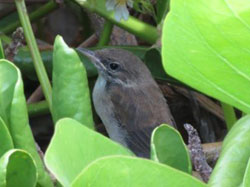
(Figure 1) A fledgling millerbird. This is one of three siblings; the largest brood of millerbirds ever documented to fledge. Credit: J. Vetter
We had yet another exciting two weeks out here with the Millerbirds. Foremost among that excitement was the fledging of three more nests, including one pair that successfully fledged three chicks, quite a rarity for the Millerbirds. Perhaps just as exciting is seeing many of the chicks that fledged early now independent and moving throughout the naupaka (Scaevola taccada) foraging on their own. It remains to be seen if the Millerbirds will continue to breed into the summer, but observations of the Laysan Finches continuing their nest-building activities bode well for the Millerbirds.
Resights were a struggle this reporting period. Females, in particular, are very difficult to find when one does not have a nest to help pinpoint them in the jungle of naupaka and beach morning glory (Ipomoea pes-caprae) where they reside. So, the "Resight of the Week" will go to the three young fledglings (one of the brood appears in Fig. 1). They hung on in the nest a little longer than many of the other chicks, but I like to think that they just wanted to wait to give me a very welcome birthday gift.
Elsewhere on the island, we had some strong rain showers this past weekend, which were a welcome relief from the heat, and, more importantly, from the burgeoning fly population. The winds that accompanied the rain were also a welcome gift to the young albatrosses. With their flight feathers mostly grown, they have started the first agonizing moments of flight training. Wings spread and hopping into the wind, a few have managed to leave the ground, albeit for short, very unsteady bursts. While masters of the wind as adults, it evidently takes a bit of practice to fully grasp the concepts of aerodynamics.
The summer population of shorebirds seems to be set and we have nearly the full complement of breeding birds on the island at the moment. While most of the birds are in the beginning or middle of their breeding season, both the Tristam's Storm-Petrel and Bonin Petrel are finishing up. While fewer and fewer adults return each night, many of the chicks are out and about on the surface during the evenings exploring life outside of the burrow before they take off into the wide Pacific.
Double Digits
May 14, 2012 - May 27, 2012
By John Vetter
Once again I get the pleasure of reporting another small milestone in the breeding success of the Millerbirds here on Laysan. Two more nests fledged this week, each nest containing two chicks. That now puts the total number of fledglings into the double digits, with ten chicks coming from seven successful nests. One pair has now fledged two successful nests for a total of three chicks. Five more nests remain active, and with the rains continuing to provide greenery for the caterpillars, moths, and other assorted insects that the Millerbirds prey upon, the breeding season may well extend into the summer. The next question is to see if the birds that have raised two broods will go for the trifecta. The Resight of the Week is going on hiatus this week. I have been able to keep tabs on most of the breeding Millerbirds over the past few weeks; having nests to bring the birds to a specific point in the featureless sea of naupaka shrubs may be providing me just a bit of help.
Breeding season is hitting its peak among the other birds on the island. Brown Noddies have started laying eggs en masse, with nests seemingly under every grass clump and bush. Gray-backed and Sooty terns are laying in many of the bare patches along the vegetation edge or interspersed amongst the tall bunches of Eragrostis grass . The White Terns are much less picky, "nesting" anywhere a flat, hard surface exists (and sometimes flat is not even vital). Many more Great Frigatebird and Red-footed Booby chicks (Photo 1) are showing up in the bushes and trees of the island. Many Black-footed and Laysan albatrosses chicks have molted into their business-like adult plumage on the body and wings, while retaining the downy flowing "hair and beard" of their youth on their heads (Photo 2). Even the non-avian residents of the island are in fine breeding form, with Hawaiian monk seal pups frolicking in the shallows and green sea turtle nests appearing on many of the beaches.
This period appeared to mark the end for some of the more unusual winter visitors we had out here on the island. Neither the Ruff nor any of the Sharp-tailed Sandpipers were observed this time. In addition, those individuals of the more common shorebirds that will breed this year have moved on as well. Scattered Pacific Golden-plovers, Wandering Tattlers, Ruddy Turnstones, and Bristle-thighed Curlews do remain, many of which will spend the summer here on Laysan. The pair of brewsteri Brown Boobies nesting on the south of the island still remains. And the Blue-Gray Noddy has decided to stick around for a while as well, being last observed on May 26th.
Full Sun and Full Moon
April 30, 2012 - May 13, 2012
By John Vetter
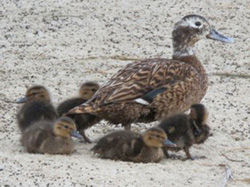
(Figure 1) Laysan Duck female and five ducklings. The Laysan Duck is an endangered species. Midway Atoll harbors the only other wild population, as a result of translocations from Laysan Island in 2004 and 2004. Credit: J. Vetter
Summer has finally arrived on Laysan. April showers have given way to the dog days of May, with temperatures beginning to climb and drier conditions prevailing. With a large full moon also showing itself this week, there seemed to be no escape from the light. The interplay between the showers and sun has been a boon to the vegetation of the island, with many plants experiencing rapid growth spurts and sweet-smelling flowers appearing everywhere. Unfortunately, the hot conditions also mean that sweet-smelling might be the last adjective used to describe the peculiar odor emanating from the hypersaline lake in the center of the island. While the sights and sounds of Laysan can be fairly accurately portrayed by audio and visual, the smells can only linger in the memory. And that one will not soon be forgotten.
The Millerbirds continue a fantastic breeding season, with yet another successful fledging. Six new birds have now left their nests this spring, with six current active nests promising more to come. All eight of our known pairs have either an active nest or are feeding young fledglings! One female has already successfully reared two chicks, and just began building nest number two. Our "Resight of the Week" was a late entry, but definitely a highlight. Rather than a banded individual, late in the week I observed one of the very first juveniles to leave the nest. The young bird has now moved out on its own away from mom and dad and is supporting itself in the dense naupaka thickets.
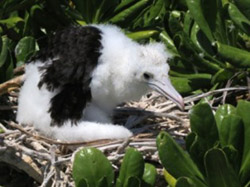
(Figure 2) A Great Frigatebird chick in the nest. This chick is just beginning to grow feathers. Credit: J. Vetter
Elsewhere on Laysan, young birds are plentiful. We had a new high count for Laysan ducklings, with 16 seen one evening (Figure 1). On the opposite end of the cuteness spectrum, more Great Frigatebird chicks are hatching and some have begun to grow in their odd black "capes" (Figure 2). The first Gray-backed Tern eggs of the season have been noted in the low fringing vegetation just inland from the beaches. And the Sooty Tern colonies seemed to have calmed a bit from their whirling, high-flying flocks, and the birds should begin to lay eggs soon as well.
Many Ruddy Turnstones, Pacific Golden-plovers, Wandering Tattlers, and Sanderlings continue to gorge on the brine shrimp and brine flies in the lake. Many more, however, have left us for the summer during the last two weeks. At least three Sharp-tailed Sandpipers were recorded together (through 5/5), and the Ruff also remained (5/5). The Blue-gray Noddy that showed up on the beach in front of camp stayed for a few days, and was last seen on 5/3. Also on May 3rd, I observed a White-tailed Tropicbird in the south of the island. This species is more commonly found on the main Hawaiian Islands nesting in cliffs and valleys, such as Waimea Canyon on Kauai or Kilauea Crater on the Big Island. Finally, a more extensive search in the south of the island revealed three individuals of the brewsteri subspecies of Brown Booby. This subspecies normally nests on the Pacific coast of Mexico, but at least two of the individuals noted were sitting on nests.
Another Round of Nests
April 16, 2012 - April 29, 2012
By John Vetter
One of the joys of being a field researcher is observing the transition and changes of the birds as the year moves along. New discoveries, new behaviors, and new successes make the early wake-up alarms worth it (though I must admit that copious amounts of coffee are a good backup). So far the spring breeding period for the Millerbirds translocated from Nihoa to Laysan has provided plenty of exciting moments. The past two weeks were no exception. Yet another young bird fledged from its nest, making five that have made the leap into the world. In addition, beautiful weather inspired another nest-building frenzy among the Millerbirds. Six new nests were discovered this week among our pairs, including two pairs who have built new nests after already producing one successful fledgling. At the moment, the indications from another round of nests are that the birds show little sign of slowing down. And in that case, the coffee will be going strong as well.
For the "Resight of the Week" this week, I am going to switch it up a bit. Since all of the resighted birds are nesting or have young juveniles, we have been able to keep close tabs on many of them over the past month. Thus, this time I am giving the honor to a young fledgling Millerbird. This bird left its nest in the first few days of April, and then proceeded to play hide-and-seek in the thick vegetation for the next couple of weeks - no doubt practicing for an adult life vexing researchers that visit Laysan. Finally, on April 20th, I was able to resight the young bird sticking close to and being fed by mom.
Among the other residents of Laysan, many first of the year chicks have been popping up, including Brown and Red-footed Boobies, Red-tailed Tropicbirds, as well as Great Frigatebirds. A number of Laysan Finch females are also on another round of eggs, while the males tend to the previous nests' juveniles. Bonin Petrel chicks have begun to get their flight feathers, even as they grow rounder and rounder. Both Black-footed and Laysan albatross chicks are looking more and more adult-like, both in size and plumage, with many starting to practice "flying" when the wind picks up. And the Bulwer's Petrel numbers increased from zero to many.
Among the migrants, Ruddy Turnstones and Pacific Golden-Plovers are still present, but some have seemingly begun the long trip north to the breeding grounds. However, Sanderling numbers have increased substantially in the last week as more migrants come through. At least two Sharp-tailed Sandpipers remain in their breeding finest (through 4/20), the Ruff is also molting into his spectacular male breeding plumage (4/20), and new this period, two Red Phalaropes made an appearance. One only stayed for one day (4/16), while the other stayed longer (4/16 through at least 4/20). I also observed one male brewsteri Brown Booby on two separate occasions. We also had another visit from a Blue-gray Noddy. However, the Peregrine Falcon has not been seen recently, and may have finally moved on.
Wind, Sand, and Stars
April 2, 2012 - April 15, 2012
By John Vetter
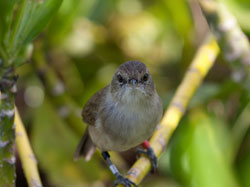
A closer look. Note color bands - in addition to a numbered metal band, each bird released on Laysan carries a unique combination of colors to permit identification using binoculars. Credit: R. Kohley
Well, these two weeks brought the extremes in windy weather to Laysan. The very windy conditions of the first week brought me to the point of wondering if I would wake up in the morning in Oz, or if my canvas "home" would stand up to the huffing and puffing of the Pacific Ocean trying to blow it down. Just walking the beach to my field site in the morning was an invigorating exfoliation usually seen only in high-class salons. Thankfully, the winds calmed, the skies cleared, and the stars blanketed the nighttime sky during the second week of this period, making for much more pleasant field days.
Millerbird activity continued at a rapid pace, with another first: two Millerbird fledglings from the same nest! We also have another two nests that are still active, one with a nestling and one still being incubated. With luck, even more Millerbirds will be hopping through the bushes on Laysan soon.
The very first fledgling was also observed and appears in great condition. The mother of this little guy was even seen collecting nesting material for another attempt, apparently not content with just one. Our "Resight of the Week" was B/S, O/O (band combination: blue over silver left leg, orange over orange right leg), who was seen for the first time since the leap day at the end of February. She is currently taking care of a nestling, and was resighted when she left the nest to make sure a Laysan Finch did not wander too close.
Laysan's other residents are continuing through various stages of breeding. Some, such as the Laysan Finch, seem to be going for a second go-around, even with many young fledglings present. We continue to see Laysan Duck ducklings foraging on brine flies with the females, Masked Booby chicks are growing out of the so-called rubber chicken phase of their early days. More and more Wedge-tailed Shearwaters continue to arrive in their attempt to honeycomb the entire island in burrows. I'm also seeing Bonin Petrel chicks more frequently at the entrance to their own burrows, sometimes, I think, because they have become too large to fit back inside. And I saw the first Bulwer's Petrels of the season this weekend.
Among the migrants, Ruddy Turnstones and Pacific Golden-plovers are still present in large numbers, with the Turnstones in particular seemingly bolstered by additional migrants. Bristle-thighed Curlews and Wandering Tattlers are also here in smaller numbers. At least one Sharp-tailed Sandpiper remains (through 4/10), the Ruff was noted again (4/10), and the Peregrine Falcon continues its residency (4/2), though interestingly it was not seen during the last week and no new prey remains were discovered in the previous known locations.
Millerbird Milestones
March 20, 2012 - April 1, 2012
By John Vetter
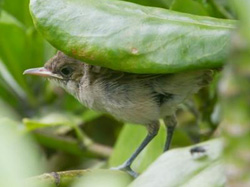
(Figure 1) The first Millerbird fledgling on Laysan in nearly 100 years. The bird is peeking from beneath a naupaka (Scaevola taccada) leaf; this plant is a dominant component of Laysan's vegetation and the Millerbirds' habitat there. Credit: R. Kohley
We have a fledgling Millerbird! I had to get that exciting bit of news out up front for my first blog post. After a whirlwind of a finale for Cameron, I jumped straight off the boat through large ocean swells into a howling rainstorm, which made for an inauspicious start to my six month tour on Laysan. However, any doubts I might have had were quickly assuaged. After the weather broke the following day, Robby and I headed out into the core Nihoa Millerbird territories, so he could point out that there is a reason that more than one person has compared the species to a mouse. A bird that prefers to hop through thick vegetation rather than fly, and do so silently, makes for a real challenge. And also makes for a constant and eerie feeling that something is always watching you. With the backing of some beautiful weather the last two weeks, Robby and I did manage to see just enough birds to mark another milestone for the establishment of the species on Laysan before he headed back to the bright lights of civilization.
After much watching and waiting, a Millerbird born on Laysan—for the first time in nearly a century—has left the nest (Fig. 1). On top of that incredible landmark, nearly all of the Millerbird pairs are showing nesting behavior, with seven nests found so far in various states of breeding. That fact shows some amazing resilience by these little birds considering the wind and sand storms of early March. It has also made for a heady and exhilarating first two weeks in the field for me. I will continue to monitor the little guy, as well as hope for more young ones "flying" away from the nest cup soon.
With all of the excitement and changes taking place for the Millerbird and Millerbird crews on Laysan, one thing that will not change is the "Resight of the Week" tradition from the previous crew. With so many nests, it becomes much easier to narrow individuals down to a spot. Obviously, the little fledgling was the most exciting sighting, but we'll stick to banded birds for now. Thus, our resight of the week was actually resighted twice this period. O/W O/S is a very difficult female to see, preferring to stay silent and low in thick naupaka bushes, so the first resight broke a stretch of over 50 days from the previous sighting on February 1. This bird has still been resighted less than 10 times since being released onto Laysan last September.
The rainstorms that hampered field work for the previous crew has been a boon to many of the birds breeding out here, including the Millerbird. Other birds on the island are getting into the act in various stages of breeding. Last Wednesday (3/28), the first Laysan Duck ducklings of the season were noted by the monument's winter crew. A few broods have been observed since, which bodes well for the species after a difficult season last year. Laysan and Black-footed Albatross chicks continue to grow larger and feistier; Black Noddy chicks observe the passing of crews from the tree in front of camp; Masked Booby chicks are beginning to appear in greater numbers; Red-footed and Brown Boobies, Red-tailed Tropicbirds, and Great Frigatebirds are all on eggs. Wedge-tailed and Christmas Shearwaters have been arriving in greater numbers to dig burrows for chicks of their own. And the Sooty Terns have begun amassing in large numbers for some noisy group time before the breeding colony becomes established.
Among the migrants, Ruddy Turnstones and Pacific Golden-plovers are still around in solid numbers, but many are beginning to show the snappy breeding plumage they will acquire before leaving for their breeding grounds later this month. At least two Sharp-tailed Sandpipers are present (through 3/29), the Gray-tailed Tattler is still around (3/31), and the Peregrine Falcon continues its residency (3/31), though increasingly on the less-visited South end of the island, precluding an accurate count of his more recent prey items. One other sighting of note was a Blue-gray Noddy, a species that is more common on other islands in the NW Hawaiian Islands, but rare on Laysan. An individual visited camp one evening before quickly departing the next morning.
A Whirlwind of a Finale
February 28, 2012 - March 19, 2012
By FWS Monitoring Team on Laysan Island: Cameron Rutt and Robby Kohley
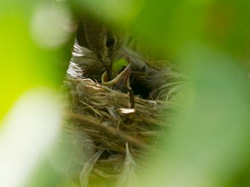
(Figure 1) A peek at the first Millerbird nestling of 2012, being fed by a parent. Credit: R. Kohley
While the weather and birds conspired to keep us guessing these past three weeks, there is no question about what our future has in store. Our imminent departure is now only nine days away (March 28th), and will mark the end of our 200 day island shift. We will then be passing the baton into the capable hands of John Vetter, who will be charged with shepherding the flock of Millerbirds into the future. Ultimately, as we're ferried off the island and Laysan is reduced to a shrinking speck on the horizon, the feelings will surely be mixed. Although we're heading back to the land of internet, cell phones, and cars we're simultaneously saying goodbye to ocean baths, canned food, and social isolation. But more importantly, we're leaving behind a host of creatures that have become more than just study organisms, but instead acquaintances, neighbors, and, dare we say, friends.
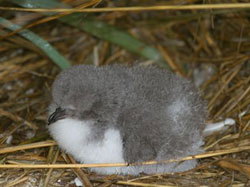
(Figure 2) A young Bonin Petrel chick. These small seabirds nest in burrows; the adults visit the colony at night. Credit: R. Kohley
Gusty, sand-blasting winds buffeted the island for nearly half (March 2nd - 11th) of these past three weeks, preventing us from fieldwork for multiple days - not quite the Laysan farewell that we had in mind. As sand pummeled beleaguered albatross chicks and spreading sand dunes spilled over adjacent vegetation, we were simply happy to have shelter. In retrospect, unlike us, it appears that the Millerbirds were doing more than simply weathering the storm. The unobtrusive breeding behavior we witnessed in late February has heralded a full-fledged breeding season. Almost, that is. There still aren't any fledglings, but the distance to that hurdle appears to be dwindling. We found two more nests last week and one of the prior nests became active, giving us a grand total of two nests with eggs and one with a single nestling (Figure 1)! The Millerbirds' business-like breeding behavior gives us confidence that, unlike our more fleeting presence, they're here to stay.
As if that wasn't enough to fill our final reporting period, let alone a single blog entry, there's more. Our "resight of the week" plugs the longest gap for any disappearing Millerbird thus far. After going into stealth mode following our previous resight (11/23), B/S, B/Bk (Blue over silver left leg, blue over black right leg), showed us her legs in surprisingly bold fashion on 3/14 (112 days later)! If we zoom out a bit, this means that she went unseen for more than half (56%) of our entire duration. Thus, resighting this elusive female had been high on our pre-embarking "to-do" list.
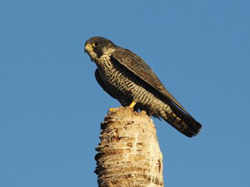
(Figure 3) The Peregrine Falcon that has spent the winter on Laysan, feeding mainly on shorebirds. Credit: C. Rutt
The changing seasons continue to be apparent: fluffy Bonin Petrel chicks redefine "cute" (Figure 2); Wedge-tailed Shearwaters have returned; Great Frigatebirds, Red-tailed Tropicbirds, and Red-footed Boobies are all on eggs; we can only assume that evolution has prepared Masked Booby chicks to blend in amongst flocks of rubber chickens (they look kind of like them); and Laysan Finches are now feeding hordes of fussy fledglings. Finally, a single "Brewster's" Brown Booby was noted (3/6); the Peregrine Falcon remains (through 3/17; its 68 totaled prey items now include 27 Pacific Golden-Plovers, 38 Ruddy Turnstones, 1 Sanderling, and 2 Laysan Finches); and the Gray-tailed Tattler (through 3/17), as many as three Sharp-tailed Sandpipers (through 3/17), and Ruff (through 3/17) all continue. These individual migrants and vagrants provide another reminder of just how long we've been here. We've now watched in time-lapse as the immature Peregrine Falcon molted into adult-like plumage (Figure 3); meanwhile, the Gray-tailed Tattler molted out of breeding plumage last fall only to have recently begun molting back into breeding plumage. So perhaps it really is time to bid farewell.
Under (cover) Construction
February 14, 2012 - February 27, 2012
By FWS Monitoring Team on Laysan Island: Cameron Rutt and Robby Kohley
Certain dates - like Valentine's Day - can trigger memory in members of our species; February 14th appears to have the same effect on Millerbirds. After nearly 3.5 months since our last observation of nest-building, it was as if, all of a sudden, the Millerbirds had checked their calendars. Not that building a nest is our idea of a great date, but on that special day, three pairs had construction on their minds. Perhaps, after all, they really were taking note of the island's only other songbird, the Laysan Finches (Figure 1), which are now feeding nestlings. In the past week-and-a-half, we've noted two other Millerbird pairs carrying material, although unlike their bout of breeding activity in the fall, this time their operations appear much more sporadic and covert. This secrecy may be beneficial to the birds, but it doesn't make our job any easier. Despite considerable effort and returning to suspicious pairs' territories for multiple mornings, we've only located a single nest. And even that felt like a major accomplishment. We watched with increasing frustration as this particular pair made a handful of visible trips, but scattered the evidence across an expansive area of dense vegetation. It was only after some creative thinking and a bit of persevering that we eventually pinpointed the nest. As it now stands, the score is Millerbirds - 4, Humans - 1. But at the end of the day, we have to remind ourselves that we're on their team too.
While the Millerbirds may believe that love is in the air, the baby albatrosses have lost some of their innocence and charm (Figure 2). We now find ourselves the enemy of an increasingly capable foe, yet their bark is still considerably worse than their bite. Trust us, we know from experience. The oldest albatross chicks are about forty days old, approximately a quarter of the way to fledging. We've been able to watch them since they were nothing more than a sparkle in their parent's eyes. But this familiarity apparently bred contempt. Our arrival into their territory predictably brings one of three responses: aggressively clapping their bills, a shy twist of the neck so that the face is effectively hidden, or some combination of the two. To add insult to injury, they've added one more grown-up behavior to their growing repertoire - the sky moo. After an altercation between two adults, the self-proclaimed victor will lift its beak skyward and, for lack of a better description, moo. After we pass by, some of the especially plucky youngsters now feel obliged to signal their alleged dominance in this fashion - the final albatross insult. Despite the disproportional growth of their umbrage as well as their bellies, they make wonderful neighbors.
The past two weeks have produced another new avian arrival. While circumnavigating the lake on 2/19, a single Green-winged Teal flushed up from the margins of an adjacent seep, making even the diminutive Laysan Ducks seem a bit hefty. Finally: a single "Brewster's" Brown Booby was again noted (2/18 and 2/24); only 2 Northern Pintails were found (2/19); the Peregrine Falcon (through 2/24) is closing in on 60 catalogued kills (the totaled prey items are now up to 24 Pacific Golden-Plovers, 32 Ruddy Turnstones, 1 Sanderling, and 2 Laysan Finches); and the Gray-tailed Tattler (through 2/26), as many as three Sharp-tailed Sandpipers (through 2/20), Dunlin (through 2/23), and Ruff (through 2/23) all continue.
Feast or Famine
January 31, 2012 - February 13, 2012
By FWS Monitoring Team on Laysan Island: Cameron Rutt and Robby Kohley
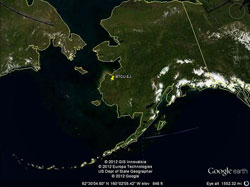
(Figure 1) The yellow pin marks the breeding ground where "EJ," the bristle-thighed curlew, was captured and banded. Credit: Google
If our previous work period was a "feast," then this most recent one, unfortunately, would fall under "famine." It seems that our fickle Millerbird friends are trying (and succeeding, we might add) to do everything in their power to defy categorization. Without obvious rhyme or reason, some days are full of activity, interspersed among days where their discreet foraging, all but invisible to us, literally tests the limits of concentration. We hope that, like us, they're taking notes of their songbird brethren - the Laysan Finches - who have begun laying eggs and incubating clutches.
With no long-lost birds resurfacing, our "resight of the week" again goes to B/S, B/W, who continues to endure the Millerbird version of a serious "time out," holed up at the south end of the island, now going on 50 days. To the best of our knowledge, there isn't a single Millerbird within a mile of this guy, not that he seems overly worried about it. We often hear his blithe mumblings, apparently unconcerned by the lack of a listening audience.
In the latest blog, we highlighted a certain Bristle-thighed Curlew - EJ - that wore a green leg flag, from a then unknown banding operation in western Alaska. Well, thanks to Kristine Sowl, a Wildlife Biologist at the Yukon Delta National Wildlife Refuge, we now know a little bit more about him. EJ was banded alongside his mate on 2 July 2011 in Alaska's Andreafsky Wilderness (Figure 1). In the first two years of this three-year study, Sowl and company have captured and flagged 69 curlews, with birds already turning up in Oahu, Midway, and now Laysan. Bristle-thighed Curlews are unique among migratory shorebirds for exclusively wintering on oceanic islands, not such a bad idea if you ask us. But first, they have to get here. For those birds embarking from the "southern" portion of their breeding range, like EJ, they must endure a 2,400 mile (4000 km) nonstop flight to reach the Northwestern Hawaiian Islands - no small task. But for others, breeding in the more northerly Seward Peninsula, a single leg of their biannual journey may exceed 3,600 miles (6000 km), ultimately depositing the worldly traveler in, say, Fiji! For more information on Sowl's study, particularly if you've seen a similarly marked curlew, please visit: http://yukondelta.fws.gov/btcu.htm (you will be directed to a U.S. Fish and Wildlife Service website).
The overwhelming avian highlight was the surprise appearance of a wayward Glaucous Gull (2/8), completely out of the blue! Far from its expected winter haunts along the coastal Pacific Northwest, this immature didn't appear particularly desperate for land. Less than a minute after being spotted, it took off, only to make one last pass before disappearing, allowing only marginal photographic documentation (and that's being generous) - our 43rd species for the island this winter. Second only to the gull on the highlight reel, many of the albatross chicks have now reached peak cuteness - if such a thing is measurable - fluffy, spunky, and alert, but not yet ballooning in size (Figure 2). Finally: a single "Brewster's" Brown Booby was again detected (2/5 and 2/9); the once flock of 18 Northern Pintails found themselves stuck in a division equation, with a denominator of three (now 6 birds only; 2/8-2/9); the Peregrine Falcon (through 2/12) continues to stockpile an impressive array of discarded wings (the totaled prey items now comprise 21 Pacific Golden-Plovers, 27 Ruddy Turnstones, 1 Sanderling, and 2 Laysan Finches); and one Sharp-tailed Sandpiper was noted (through 2/8).
20/20 Vision
January 17, 2012 - January 30, 2012
By FWS Monitoring Team on Laysan Island: Cameron Rutt and Robby Kohley
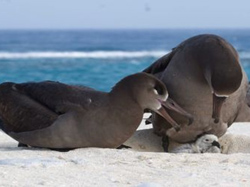
(Figure 1) The yellow pin marks the breeding ground where "EJ," the bristle-thighed curlew, was captured and banded. Credit: Robby Kohley
Just one work period after reveling in the accomplishment that was 20 birds in 21 days, we somehow managed to drastically increase the efficacy of our efforts this past work period. How about 20 different millerbirds in only five work days!? This formerly far-fetched dream miraculously became our reality, where two days in particular found us resighting millerbirds with virtual ease. We posted our best single-day resighting output of the season on 1/19, with nine different individuals, followed by an eight-resight day nipping closely at its heels (1/23), reminiscent of those September glory days. Not too shabby considering our quarry is a 12 centimeter, 18 gram bird that could be anywhere on an island of approximately 1.4 square miles. Despite these successes, however, we're acutely aware of the work that remains to be done, particularly homing in on those last few missing millerbirds. On that note, our "resight of the week" plugged one of those gaps, the one that O/W, O/S [orange over white left leg; orange over silver right leg] left when she all but disappeared following our last resight (11/28), 56 days before we managed to catch up with her once again (1/23).
We're not sure whether we or the parents had more anticipation, but, at long last, the albatross chicks have arrived! After more than two months of incubation, the first members of the 2012 cohort finally appeared, with a Black-footed chick 1/17 and a baby Laysan Albatross the next day (1/18). The chicks don't get to see a whole lot of the sun, as the smothering parents keep them on a strict schedule of brooding, preening, and intermittent feeding. But the majority of each day passes with the chicks quite literally sandwiched beneath the secure warmth of the parents' brood patch. Every day, new hordes of recently-hatched, peeping, grayish-white fluff-balls populate the island, adding a cute factor to the island which had otherwise been lacking (no offense to the other crew). Our first impressions, however, are that their cuteness might be tempered by their unwieldy beak, which may take a bit of growing into. Or perhaps it adds to their charm. In any case, we and the chicks have months to figure that out. The constant supervision of the parents will soon come to an end (Figure 1), with the chicks left to fend for themselves, and their growing hunger, while they patiently wait for that coveted next meal.
Signs of spring are already in the air: Great Frigatebirds with an excess of hormones on display; grounded Red-tailed Tropicbirds, Red-footed Boobies awkwardly navigating the sand in search of sticks; Gray-backed Terns on eggs, and Laysan Finches building nests. A Bristle-thighed Curlew with a green leg flag - evidently from a recent banding program in Alaska's Yukon-Kuskokwim Delta - was seen 1/27, our first and only of the season. We'll call him EJ for short (Figure 2). Finally: the whimsical Lesser Frigatebird reappeared (1/26-1/27); the wary flock of 18 Northern Pintails (through 1/21) made a showing with the single American Wigeon (through 1/21) in tow; the Peregrine Falcon (through 1/30) continues to crash the shorebird's utopic winter resort (the pile of leftover wings now amounts to 45 birds, 44 of which are shorebirds); despite 24 Peregrine-consumed Ruddy Turnstones, our high count for that species was surpassed (2,746 on 1/21); and the Gray-tailed Tattler (through 1/25), as many as three Sharp-tailed Sandpipers (through 1/23), Dunlin (through 1/23), and Ruff (through 1/21) all continue.
Hiding in Plain Sight
January 3, 2012 - January 16, 2012
By FWS Monitoring Team on Laysan Island: Cameron Rutt and Robby Kohley
The once reticent millerbirds at last appear ready to announce their emergence from hibernation. Not quite garrulous, but decidedly more chatty than their muted monotony of November and December, which was so disquieting for us and our resighting efforts. This behavioral resurgence is a most welcome change of pace and in the past three weeks we've managed to locate no less than 20 of the 24 millerbirds. Whether or not there is any correlation, this activity surge has coincided with the arrival of more seasonal wintry weather. The nearly rain-free days of December, with its abundance of sunshine and temperatures that still soared into the 90s, may now be behind us. With January, the weather has given way to chilling lows (56° F!) and brisk highs (73° F), but I doubt we're drumming up much of any sympathy from our mainland audience. Oh, and a day with 2+ inches of rain. Now where are those long pants?
Despite relocating B/S, B/W* in his self-imposed solitary confinement at the southern tip of the island, there is no competition for this installment's "resight of the week." That singular honor goes to G/Bk, O/S* (#3) who was on our "most wanted" list after going AWOL following an 11/3 resight. After more than two months, a routine visit (1/6) to an occupied territory yielded an unknown singer along the outskirts of the northern vegetation. Much to our surprise, there was G/Bk, O/S (#3) - 64 days since we had last laid eyes on this mysterious male! And to make matters even more perplexing, this was a location that we had regularly visited throughout November and December. How a male could reappear in this fashion, singing in the midst of core millerbird habitat no less, is beyond us. Where he spent those months is anybody's guess. Or perhaps he just broke his vow of silence. Whatever the case, the shadowy nature of these millerbirds can transform a seemingly routine resight into a surprising discovery.
The ill-fated chased-by-a-Peregrine list now includes Bristle-thighed Curlew, in addition to the regimen of smaller shorebirds. So far, we've watched as it gave chase to a Wedge-tailed Shearwater, Great Frigatebirds, an adult Red-tailed Tropicbird, Black and Brown Noddies, White Tern, and Laysan Finches. Our holiday scrooge - the Short-tailed Albatross - was back from its nearly three-week hiatus (1/11), having chosen to spend Christmas and New Years at sea. The first Humpback Whale of the season spouted its offshore greetings (1/11) before flipping a fluke of a farewell. Finally: single "Brewster's" Brown Boobies made appearances (1/6 and 1/13); the well-fed Peregrine Falcon (through 1/15) apparently shows no intentions of dieting as its 2012 resolution, maintaining its breakneck pace of nearly a bird/day (its totaled roosting fare has increased to include 17 Pacific Golden-Plovers, 19 Ruddy Turnstones, 1 Sanderling, and 1 Laysan Finch); our high count for Sanderlings was eclipsed (111 on 1/3); and the Gray-tailed Tattler (through 1/13), Wood Sandpiper (through 1/13), 2 Sharp-tailed Sandpipers (through 1/13), Dunlin (through 1/13), and Ruff (through 1/13) all continue.
*B/S, B/W = blue over silver on left leg; blue over white on right leg
G/Bk, O/S = green over black on left leg; orange over silver on right leg
View 2014 Updates.
View 2013 Updates.
View 2011 Updates.
Click Here for photos, videos and more information (you will be directed to a U.S. Fish and Wildlife Service website).
Click Here to view the March 16, 2012 Press Release (270kb pdf).
Click Here to view the Honolulu Magazine (February 2012) article "Millerbirds on Laysan Island" (you will be directed to a non-NOAA website).
